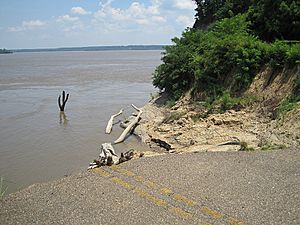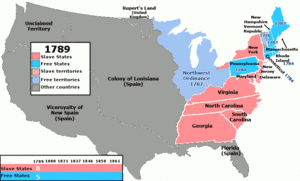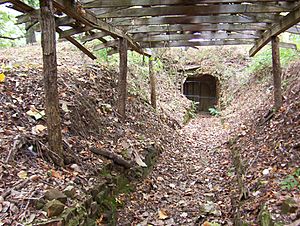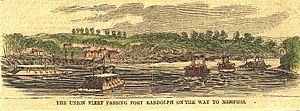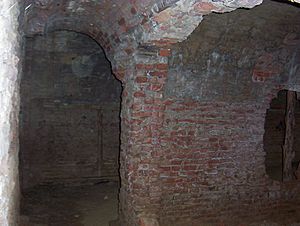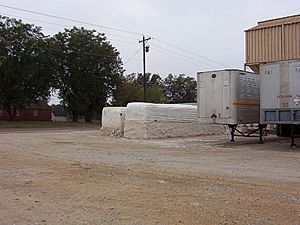History of Randolph, Tennessee facts for kids
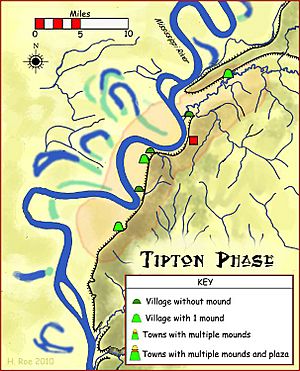
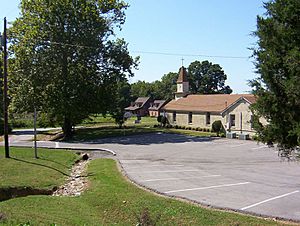
Randolph is a small, rural community in Tipton County, Tennessee, United States. It sits right on the banks of the mighty Mississippi River. For thousands of years, the land around the Mississippi River was home to early people called Paleo-Indians. Later, Native American tribes of the Mississippian culture lived here. The Tipton phase people and the Chickasaw tribe lived in the Mississippi River valley near Randolph.
In 1541, a Spanish explorer named Hernando de Soto might have crossed the Mississippi River near Randolph. Later, in 1682, French explorer René-Robert Cavelier, Sieur de La Salle built the first French fort in the area during his canoe trip down the Mississippi River.
European settlers began arriving around 1800. The town of Randolph was officially started in the 1820s. It was one of the first European settlements in Tipton County. Randolph was in a great spot on the second Chickasaw Bluff, right where the Hatchie River meets the Mississippi. This made it a perfect harbor for flatboats and steamboats. Because of this, Randolph quickly became an important trading hub in West Tennessee.
Until 1840, Randolph shipped more cotton every year than even Memphis! The town's success also relied on the use of enslaved people who worked in the cotton fields. The Randolph Post Office opened in 1827. By 1834, the first pastor was appointed to the Randolph Methodist church.
However, Randolph's luck started to change in the late 1840s. Plans for a railroad didn't work out, and the mail route wasn't helpful. Also, an attempt to move the county seat from Covington to Randolph failed. An unfinished project to dig a canal from the Hatchie River to the Tennessee River also hurt the town's business.
During the American Civil War, the first Confederate States Army fort in Tennessee was built at Randolph in 1861. A second fort was built later that year. Sadly, the town was burned down twice by Union Army forces during the war. This caused the once-busy community to decline even more.
In 2008, the Randolph Bluff Historic Park was opened. This park helps share the community's Civil War history. It also lets more people enjoy the amazing views of the Mississippi River. The park will become part of the Mississippi River Corridor Tennessee. This project aims to create a beautiful road that connects historic places along the river. In 2008, Randolph had about 200 people living there and around two dozen homes. The community's economy is mostly farming, with no big businesses or factories.
Early People and Cultures
From about 10,000 BCE, Paleo-Indians and later Archaic-Indians lived as hunter-gatherers in what is now the southern United States. Around 800 to 1600 CE, the Mississippi River Delta was home to tribes of the Mississippian culture. These Native American people built large mounds and had developed during the late Woodland Indian time.
The Tipton phase people were a local group of the Mississippian culture. They lived in the Tipton County area when Europeans first arrived with the de Soto Expedition. By the end of the Mississippian period, the Chickasaw tribe claimed and lived on this land. We don't know the exact origins of the Chickasaw people. Several ancient Native American settlements were located near where Randolph would later be built.
European Settlers Arrive
First Explorers
The exact history of European exploration in Randolph is a bit unclear. It's possible that Hernando de Soto crossed the Mississippi River near Randolph in 1541. However, he more likely crossed closer to modern-day Memphis.
In 1682, French explorer René-Robert Cavelier, Sieur de La Salle led a canoe trip to explore the Mississippi River basin. La Salle's group built a wooden fort called Fort Prudhomme. Its exact location is debated, but it might have been on Chickasaw Bluff near modern Randolph. This was the first structure built by the French in Tennessee.
First European Settlers

Around 1800, Europeans started settling the land east of the Mississippi River. This land had been home to the Chickasaw Indians for centuries. The Chickasaw land in West Tennessee and southwestern Kentucky was given up in the Jackson Purchase. This happened after talks where the United States was represented by General Andrew Jackson and Governor Isaac Shelby. The Chickasaw were represented by their chiefs and warriors. In 1818, both sides agreed to the transfer by signing the Treaty of Tuscaloosa. In this treaty, the United States agreed to pay the Chickasaw $300,000. In return, they got the right to the land east of the Mississippi River and north of the Mississippi state line.
Early European landowners were eager to protect their land investments in southwest Tennessee. Years before Randolph was founded, rich and powerful investors tried to make money from their land. In 1818, Judge John Overton wrote to General James Winchester. He said, "We must not let the owners of the property on the Bluffs at the Mississippi above us be beforehand in laying off town—as it might damp the sale of ours." Overton and Winchester, along with Andrew Jackson, founded Memphis, Tennessee in 1819. They wanted to protect their investments in the Memphis area. Andrew Jackson (1767–1845) later became the 7th President of the United States in 1829.
Both Memphis and Randolph are located on one of the four Chickasaw Bluffs. Randolph is on the second bluff, and Memphis is on the fourth. In the early 1800s, the Chickasaw Bluffs offered good spots for a harbor on the Mississippi River for both new towns. In 1820, the area that would become Randolph had about 54 people.
Town Established
In the early 1820s, landowners John T. Brown and Robert Bedford owned the land on the second Chickasaw Bluff. This land would become Randolph a few years later. They described the area as "a good landing for Mississippi River flatboats." It was only about 40 to 50 miles (64 to 80 km) north of Memphis by water. The Hatchie River, which joins the Mississippi River just north of the second Chickasaw Bluff, was deep enough for steamboats for 60 miles (97 km) upstream to Bolivar. Brown and Bedford chose this spot on the second Chickasaw Bluff to plan out Randolph, a promising river town.
The Tennessee Encyclopedia of History and Culture says Randolph was officially established in 1823. Other reports say it was founded in 1827 or 1828. The founders named the community after John Randolph of Roanoke (1773–1833). He was a leader in the United States Congress from Virginia. He spoke for the "Old Republican" group, which wanted to limit the power of the federal government.
Cotton Trade and Success
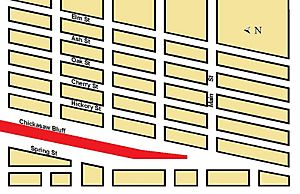
Randolph's location on the Mississippi River and the second Chickasaw Bluff made it a perfect harbor for steamboats and flatboats. This was true no matter how high or low the river was. Randolph became the main center for steamboat trade in Tennessee. It was also an important place for shipping cotton in the 1830s. The town was an early competitor to Memphis for control of trade on the Mississippi River.
In 1830, Randolph was the most important shipping point in Tennessee. In the mid-1830s, Randolph shipped 35,000 to 40,000 bales of cotton on the Mississippi River each year. By 1839, cotton shipments were still high, at 20,000 to 25,000 bales. More cotton was shipped from Randolph than from Memphis until 1840. At its busiest time, the community was called the "great steamboat depot of West Tennessee".
By 1829, Randolph had three large warehouses, six dry goods stores, ten doctors, and one tavern. About 20 to 30 families lived and worked in the area around Randolph. In the early 1830s, the town grew quickly. Randolph had about 1,000 people in 1834. By then, the town had four hotels, almost fifty businesses (including a distillery), several private schools, and more than ten saloons. The first bank in Randolph was opened "some time in the thirties" of the 19th century.
In the 1830s, two newspapers were published in Randolph: the Randolph Recorder and the Randolph Whig. The Randolph Recorder was started in 1834 by F. S. Latham. It was the first newspaper in Tipton County. The paper continued until 1836. The Randolph Whig started either in late 1836 or early 1837. Its first issue was published on January 6, 1838, but it did not last long.
Travel Routes
A stagecoach line, started in 1833 by James Brown, connected Randolph and Jackson. Jackson is about 70 miles (113 km) east of Randolph. The stagecoach line offered a convenient way for travelers between the two towns. It also connected the villages along the way twice a week.
Later in the 1830s, Randolph was connected by a direct road to Memphis. Memphis is about 25 miles (40 km) south of Randolph. This road was part of a weekly mail line between Jackson and Memphis. Mail was carried on horseback. This route linked the two busy towns and connected the settlements along the Mississippi River in Tipton and Shelby Counties for trade and travel.
Slavery
A big reason for Randolph's business success was the use of enslaved people. They worked in the cotton fields of the area for their owners. Slavery was common in the Southern States before and during the Civil War. Landowners who ran large farms, called plantations, bought enslaved people to work their fields. They mostly grew cotton, but also corn, beans, and peas.
In the Randolph Recorder newspaper during the early 1830s, landowners advertised public auctions of enslaved people they owned. For catching and returning enslaved people who had run away, plantation owners offered money rewards between $10 and $100. Rewards up to $300 were offered if someone stole an enslaved person and the thief was caught. The Tipton County jail also published "jailer's notices" in the Randolph Recorder. These notices told owners if their enslaved person was being held in jail.
The end of slavery was prepared by Abraham Lincoln's Emancipation Proclamation in 1862–63. Slavery in the United States finally ended when the 13th Amendment to the Constitution was approved on December 6, 1865. This amendment stated that "Neither slavery nor involuntary servitude (...) shall exist within the United States". Abraham Lincoln (1809–65) was the 16th President of the United States.
Decline
The good times for Randolph started to fade in the late 1840s and 1850s. This was due to many reasons. Five years after the town was founded, a problem arose over who truly owned the land. A lawsuit with landowner Ann Grambelling from New York "prevented the growth of population" until 1835. The people of Randolph bought back the land for $8,000 to settle the issue.
An inconvenient mail route also hurt the town early on. When the main mail route was set up in 1829, it went from Nashville to Jackson, Bolivar, Somerville, Raleigh, and ended in Memphis. Randolph was left out of this main route. It was placed at the end of a side route and received mail only once a week.
Failed railroad plans also contributed to the town's decline. In 1852, Randolph residents tried to move the county seat from Covington to Randolph, but they failed. The attempt was defeated by "a bare majority of voters."
Financial problems and Davy Crockett's failed attempt to dig a canal from the Hatchie River to the Tennessee River also negatively affected Randolph's future business success. Early in the Civil War, in March 1862, Randolph was described as having "half a dozen or so dilapidated frame houses." During the Civil War, the town was burned down twice, once in September 1862 and again in 1865. This made many residents not want to rebuild their homes and businesses, which further led to the community's decline.
Civil War
Fort Wright
Fort Wright was the first fort built by the Confederate Army at Randolph. On January 20, 1861, the Memphis Appeal newspaper suggested building a fort at Randolph to protect Memphis from invaders. On April 26, 1861, Brigadier General Gideon J. Pillow told LeRoy Pope Walker, the first Confederate Secretary of War, that Randolph was "the most eligible situation for a battery to protect Memphis."
Within a few days, in late April of that year, Tennessee Governor Isham G. Harris ordered a camp to be set up at Randolph and the fort to be completed. About 5,000 troops from Tennessee, Arkansas, and the Confederate Army were stationed there to build the fort. It took four months to strengthen the bluff at Randolph with earth defenses and cannons. This was to protect the fort from attacks by land and by ships. By June 1861, the fort was not fully finished, but 50 cannons were ready at Fort Wright.
Nathan Bedford Forrest (1821–77) and Alexander P. Stewart (1821–1908) trained at Fort Wright. Other future leaders in the Army of Tennessee and Forrest's cavalry also trained there. The fort was Tennessee's first military training camp. Fort Wright was the most advanced defensive position on the Mississippi River until July 1861. The Confederate foot soldiers left it by 1862, but other Southern forces used it sometimes during the Civil War. In 2008, only a powder magazine is left of Fort Wright.
Fort Randolph
Fort Randolph was the second Confederate stronghold in the area during the Civil War. It was built only months after Fort Wright, in the fall of 1861. This fort was located on the Mississippi River bluffs, about 1 mile (1.6 km) southwest of Fort Wright.
A report published by the New York Times in March 1862 described Fort Randolph as a "rough and incomplete earthwork (...) more than 100 feet above the river." The fort's location allowed a view of the Mississippi River for 6 miles (9.7 km) both upstream and downstream. Boats coming towards the fort could be seen early from this strong position. Confederate troops could get ready for naval attacks on the fort. They could also attack Union Army supply boats passing on the Mississippi River from their high position with little risk of being attacked back right away. In 2008, Fort Randolph no longer exists.
Destruction
In 1862, Union Army Major General William T. Sherman (1820–91) and his troops took control of the defeated Confederate stronghold of Memphis and the areas around it. This included the Randolph region, which is about 25 miles (40 km) north of Memphis by land. While trying to keep the area under Union control, Sherman became very "frustrated by the constant guerrilla activity in his sector." Confederate guerrillas from the Randolph area weakened the Union forces. They raided their supplies and shot at boats that delivered goods to the invading forces along the Mississippi River.
The Union supply ship Eugene was shot at by Confederate bushwhackers at Randolph in September 1862. It was carrying supplies to Memphis. Major General Sherman was frustrated with these attacks and with the people who helped the guerrillas. He ordered Colonel Charles C. Walcutt of the 46th Ohio Infantry to Randolph. Sherman told his officer that "the attack on the Eugene was by a small force of guerrillas from Loosahatchie, who by this time have gone back, and therefore you will find no one at Randolph; in which case you will destroy the place, leaving one house to mark the place." Union Army soldiers under Colonel Walcutt's command burned Randolph. This was in response to the guerrilla activities coming from the area.
Sherman reported to his superior officer, Major General Ulysses S. Grant, that he had "given public notice that a repetition [of guerrilla attacks] will justify any measures of retaliation, such as loading the boats with guerrilla prisoners where they would receive fire, and expelling families from the comforts of Memphis, whose husbands and brothers go to make up the guerillas." In 1869, Ulysses S. Grant (1822–85) became the 18th President of the United States. William T. Sherman later became the commanding General of the United States Army.
Randolph was burned down a second time by federal soldiers in 1865.
Church History
Randolph United Methodist Church
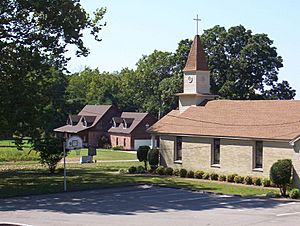
The town of Randolph was founded either in 1823 or a few years later, in 1827 or 1828. In 1834, Reverend Samuel R. Davidson became the first pastor at Randolph. He was appointed by the Tennessee Conference of the United Methodist Church. This group focuses on "developing principled Christian leaders for the church" and appoints church leaders. After Davidson became pastor, a group of people formed a church and built a building in Randolph.
Almost 20 years after the Civil War ended, the second church building in Randolph was built by the congregation in 1883. In 1953, a new church building was finished on the second Chickasaw Bluff. This building was updated in 1975. As of 2008, it serves as a place of worship for the Methodist community in Randolph.
The United Methodist Church at Randolph had 78 pastors by 1983. William Clyde Martin (1893–1984) was born in Randolph and grew up in the Methodist community there. Martin later became a bishop of several Methodist churches. He also served in the military service during World War II in the Pacific as a Methodist pastor. Later in his life, he became President of the Methodist Council of Bishops. Bishop Martin retired in 1964 and passed away in 1984.
In 2008, Reverend Thomas M. Yoder and Reverend Ben Rainey were the appointed pastors at the Randolph Methodist community. Randolph United Methodist Church is located at 98 Ballard Slough Road. The church reported an average of 76 members attending worship.
Randolph Assembly of God
Randolph Assembly of God is another place of worship in Randolph. This church was founded in 2001. In 2008, Pastor Larry Rose and Pastor Frank Russell led the congregation. Randolph Assembly of God is located at 1135 Randolph Road.
Modern Randolph
Farming is the main way people make money in the area around Randolph. Growing cotton is especially important. Corn, beans, and peas were also grown in the 1800s. After slavery ended in 1865, sharecropping became the main way for low-income families to earn money. Sharecroppers would use land to grow cotton, and in return, they would give a part of their crop to the landowner. Over time, modern machines like the cotton picker replaced manual labor.
On October 11, 2008, the Tennessee Parks and Greenways Foundation opened Randolph Bluff Historic Park. This non-profit group celebrated with politicians, conservationists, historians, and community members. The 19-acre (7.7 ha) property on the second Chickasaw Bluff was bought for $378,000. The park aims to share the community's Civil War history and let more people enjoy the unique views of the Mississippi River. More money from tourism is expected for the community.
Once Randolph Bluff Historic Park is finished, it will be part of the Mississippi River Corridor Tennessee. This project aims to "create a scenic byway that connects historic sites along the Mississippi River." The project also helps with economic growth and protecting land and wildlife in the Tennessee counties along the Mississippi River.
In 2008, Randolph had about 200 people living there and around two dozen homes. The economy of this rural community is mostly farming, with no major industries or businesses.
Images for kids
-
Old Randolph Road in Memphis, Tennessee (2010).



